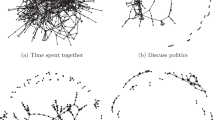Abstract
A large body of research aims to detect the spread of something through a social network. This research often entails measuring multiple kinds of relationships among a group of people and then aggregating them into a single social network to use for analysis. The aggregation is typically done by taking a union of the various tie types. Although this has intuitive appeal, we show that in many realistic cases, this approach adds sufficient error to mask true network effects. We show that this can be the case, and demonstrate that the problem depends on: (1) whether the effect diffuses generically or in a tie-specific way, and (2) the extent of overlap between the measured network ties. Aggregating ties when diffusion is tie-specific and overlap is low will negatively bias and potentially mask network effects that are in fact present.
Access this chapter
Tax calculation will be finalised at checkout
Purchases are for personal use only
Similar content being viewed by others
Notes
- 1.
- 2.
For a case in point, see [14], which shows that evidence of behavior spreading through the network is masked when the seven types of ties are aggregated. When disaggregated, the authors find evidence consistent with specific diffusion along the most intimate types of ties.
- 3.
- 4.
- 5.
The magnitude of \(\beta \) affects the severity of the attenuation bias, not whether it is present or not.
References
Alatas, V., Banerjee, A., Chandrasekhar, A.G., Hanna, R., Olken, B.A.: Network structure and the aggregation of information: theory and evidence from Indonesia. Am. Econ. Rev. 106(7), 1663–1704 (2016)
Baldassarri, Delia: Cooperative networks: altruism, group solidarity, reciprocity, and sanctioning in Ugandan producer organizations. Am. J. Sociol. 121(2), 355–395 (2015)
Bandiera, O., Rasul, I.: Social networks and technology adoption in northern Mozambique. Econ. J. 116(514), 869–902 (2006)
Banerjee, A., Chandrasekhar, A.G., Duflo, E., Jackson, M.O.: The diffusion of microfinance. Science 341(6144), 1236498 (2013)
Bearman, P.S., Moody, J., Stovel, K.: Chains of affection: the structure of adolescent romantic and sexual networks. Am. J. Sociol. 110(1), 44–91 (2004)
Cai, J., De Janvry, A., Sadoulet, E.: Social networks and the decision to insure. Am. Econ. J. Appl. Econ. 7(2), 81–108 (2015)
Cruz, C., Labonne, J., Querubin, P.: Politician family networks and electoral outcomes: evidence from the Philippines. Am. Econ. Rev. 107(10), 3006–37 (2017)
Ferrali, R., Grossman, G., Platas, M., Rodden, J.: Peer effects and externalities in technology adoption: evidence from community reporting in Uganda. SSRN (2018)
Gondal, N.: Multiplexity as a lens to investigate the cultural meanings of interpersonal ties. Social Netw. 68, 209–217 (2022)
Greene, W.H.: Econometric Analysis. Pearson Education India (2003)
Kremer, M., Miguel, E.: The illusion of sustainability. Quarter. J. Econ. 122(3), 1007–1065 (2007)
Larson, J.M., Lewis, J.I:. Ethnic networks. Am. J. Polit. Sci. 61(2), 350–364 (2017)
Larson, J.M., Lewis, J.I.: Measuring networks in the field. Polit. Sci. Res. Methods 8(1), 123–135 (2020)
Larson, J.M., Lewis, J.I., Rodríguez, P.: From chatter to action: how social networks inform and motivate in rural Uganda. Brit. J. Polit. Sci. (2021). https://doi.org/10.1017/S0007123421000454
Mattie, H., Onnela, J.-P.: Edge overlap in weighted and directed social networks. Netw. Sci. 9(2), 179–193 (2021)
Mesch, G., Talmud, I.: The quality of online and offline relationships: the role of multiplexity and duration of social relationships. Inf. Soc. 22(3), 137–148 (2006)
Peng, J., Agarwal, A., Hosanagar, K., Iyengar, R.: Network overlap and content sharing on social media platforms. J. Market. Res. 55(4), 571–585 (2018)
Sinclair, B., McConnell, M., Michelson, M.R.: Local canvassing: the efficacy of grassroots voter mobilization. Polit. Commun. 30(1), 42–57 (2013)
Stefanski, L.A., Carroll, R.J.: Covariate measurement error in logistic regression. Ann. Stat. 1335–1351 (1985)
Author information
Authors and Affiliations
Corresponding author
Editor information
Editors and Affiliations
Rights and permissions
Copyright information
© 2023 The Author(s), under exclusive license to Springer Nature Switzerland AG
About this paper
Cite this paper
Larson, J.M., Rodríguez, P.L. (2023). Sometimes Less Is More: When Aggregating Networks Masks Effects. In: Cherifi, H., Mantegna, R.N., Rocha, L.M., Cherifi, C., Miccichè, S. (eds) Complex Networks and Their Applications XI. COMPLEX NETWORKS 2016 2022. Studies in Computational Intelligence, vol 1077. Springer, Cham. https://doi.org/10.1007/978-3-031-21127-0_18
Download citation
DOI: https://doi.org/10.1007/978-3-031-21127-0_18
Published:
Publisher Name: Springer, Cham
Print ISBN: 978-3-031-21126-3
Online ISBN: 978-3-031-21127-0
eBook Packages: EngineeringEngineering (R0)




